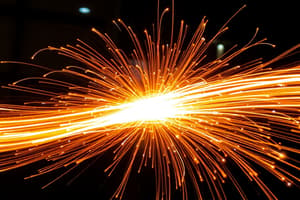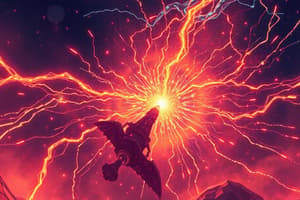Podcast
Questions and Answers
A box is pushed with a force of 50 N over a distance of 10 meters. If the force is applied at an angle of 60 degrees with respect to the direction of motion, what is the work done?
A box is pushed with a force of 50 N over a distance of 10 meters. If the force is applied at an angle of 60 degrees with respect to the direction of motion, what is the work done?
- 2500 J
- 433 J
- 250 J (correct)
- 500 J
According to the law of conservation of energy, the total amount of energy in a closed system decreases over time.
According to the law of conservation of energy, the total amount of energy in a closed system decreases over time.
False (B)
Define power in terms of work and time, and provide its formula.
Define power in terms of work and time, and provide its formula.
Power is the rate of doing work. Its formula is $P = \frac{W}{t}$
If a machine does 500 J of work in 5 seconds, its power output is ______ Watts.
If a machine does 500 J of work in 5 seconds, its power output is ______ Watts.
Match the following scenarios with the type of energy primarily involved:
Match the following scenarios with the type of energy primarily involved:
Flashcards
Work
Work
Energy transferred when force moves an object over a distance.
Power
Power
Rate at which work is done.
Formula for Work
Formula for Work
W = Fd or W = Fd cos θ.
Kinetic Energy
Kinetic Energy
Signup and view all the flashcards
Law of Conservation of Energy
Law of Conservation of Energy
Signup and view all the flashcards
Study Notes
Work
- Energy transferred when force is exerted to move an object a certain distance
- Work is done when displacement and force are parallel to each other
Formulas
- W = Fd
- W = Fd cos θ (where θ is the angle between force and displacement)
- F = W/d
- d = W/F
Angle and Work
- 90° angle = no work
- 180° angle = negative work
Power
- Rate of doing work or how fast work is done
- Power (P) = Work (W) / Time (t)
- Power (P) = Watts (W)
- Time is measured in seconds
- Gravity (g) = 9.8 m/s²
Energy
- Ability to do work
- States of energy
- Potential energy (energy of position)
- Kinetic energy (energy of motion)
- Greater the mass of an object, greater its kinetic energy
- Law of Conservation of Energy:
- Energy cannot be created or destroyed
- Energy can be transferred or converted into different forms
- The amount of energy stays the same
Studying That Suits You
Use AI to generate personalized quizzes and flashcards to suit your learning preferences.




